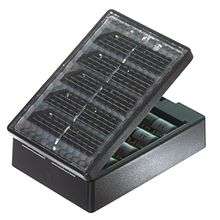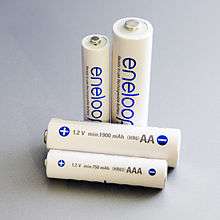AA battery

An AA battery—also called a double A or Mignon (French for "dainty") battery—is a standard size single cell cylindrical dry battery. The IEC system calls it size R6, and ANSI calls it size 15.[1] Historically, it is known as HP7 in the United Kingdom.
AA batteries are common in portable electronic devices. An AA battery is composed of a single electrochemical cell that may be either a primary battery (disposable) or a rechargeable battery. The exact terminal voltage and capacity of an AA size battery depends on cell chemistry.
Introduced in 1907,[2] the AA battery size was standardized by the American National Standards Institute (ANSI) in 1947, but it had been used in flashlights and electrical novelties for some time before formal standardization. ANSI and IEC Battery nomenclature gives several designations for cells in this size, depending on cell features and chemistry.
Dimensions

An AA cell measures 49.2–50.5 mm (1.94–1.99 in) in length, including the button terminal—and 13.5–14.5 mm (0.53–0.57 in) in diameter. The positive terminal button should be a minimum 1 mm high and a maximum 5.5 mm in diameter, the flat negative terminal should be a minimum diameter of 7 mm.[1]
Alkaline AA cells have a weight of roughly 23 g (0.81 oz),[3] lithium AA cells have a mass around 15 g (0.53 oz),[4] and rechargeable Ni-MH cells around 31 g (1.1 oz).[5]
Chemistry and capacity
Primary cells
Primary (non-rechargeable) zinc–carbon (dry cell) AA batteries have around 400–900 milliamp-hours capacity, with measured capacity highly dependent on test conditions, duty cycle, and cut-off voltage. Zinc–carbon batteries are usually marketed as "general purpose" batteries. Zinc-chloride batteries store around 1000 to 1500 mAh are often sold as "heavy duty" or "super heavy duty". Alkaline batteries from 1700 mAh to 3000 mAh cost more than zinc-chloride batteries, but last proportionally longer.
Non-rechargeable lithium batteries are manufactured for devices that use a lot of power, such as digital cameras, where their high cost is offset by longer running time between battery changes and more constant voltage during discharge.
Lithium-iron disulfide batteries can have an open-circuit voltage as high as 1.8 volts, but the in-circuit voltage reduces, making this chemistry compatible with equipment intended for zinc-based batteries. A fresh alkaline zinc battery can have an open-circuit voltage of 1.6 volts, but an iron-disulfide battery with an open-circuit voltage below 1.7 volts is entirely discharged.[6]
Rechargeable cells


Rechargeable batteries in the AA size are available in multiple chemistries: nickel–cadmium (NiCd) with a capacity of roughly 600–1000 mAh,[7] nickel–metal hydride (NiMH) in various capacities of 1300–3500 mAh and lithium ion. Lithium ion chemistry has a nominal voltage of 3.6 volts. They are referred to as 14500 Li-ion batteries.
Nickel-zinc cell (NiZn) AAs are also available, but not widely used.
Comparison
| Type | Zinc–Carbon | Alkaline | RAM | Li-FeS2 | Li-ion | NiCd | NiMH | NiZn |
|---|---|---|---|---|---|---|---|---|
| IEC name | R6 | LR6 | LR6 | FR6 | ? | KR6 | HR6 | ZR6 |
| ANSI/NEDA name | 15D | 15A | 15A | 15LF | 14500 | 1.2K2 | 1.2H2 | ? |
| Capacity under 50 mA constant drain | 400–1700 mAh | 1800–2600 mAh | 1800–2600 mAh | 2700–3400 mAh | 600-800 mAh | 600–1000 mAh | 600–2850 mAh | 1500–1800 mAh |
| Nominal voltage | 1.5 V | 1.5 V | 1.5 V | 1.5 V | 3.6-3.7 V | 1.2 V | 1.2 V | 1.6-1.65 V |
| Max. energy at nominal voltage and 50 mA drain | 2.55 Wh | 3.90 Wh | 3.90 Wh | 5.10 Wh | 2.88-2.96 Wh | 1.20 Wh | 3.42 Wh | 2.97 Wh |
| Rechargeable | No | No | Yes | No[8] | Yes | Yes | Yes | Yes |
Use
In 2011, AA cells accounted for approximately 60% of alkaline battery sales in the United States. In Japan, 58% of alkaline batteries sold were AA, known in that country as tansan (単三). In Switzerland, AA batteries totaled 55% in both primary and secondary (rechargeable) battery sales.[9][10][11]
See also
References
- 1 2 Classic (LR6) datasheet from energizer.com
- ↑ http://www.eveready.com/about-us/Pages/about-eveready.aspx
- ↑ "Energizer Alkaline AA Battery Specification" (PDF). Product Datasheet. Energizer. Retrieved October 21, 2015.
- ↑ "Energizer Lithium AA Battery Specification" (PDF). Energizer. Retrieved October 21, 2015.
- ↑ "Energizer NiMH AA Battery Specification" (PDF). Energizer. Retrieved October 21, 2015.
- ↑ Lithium Iron Disulfide Handbook and Application Manual, Version LI4.04, Energizer Battery Manufacturing Inc.
- ↑ Bergveld, H; Kruijt, W; Notten, P (February 1999). "Electronic-network modelling of rechargeable NiCd cells and its application to the design of battery management systems". Journal of Power Sources. 72 (2): 143–158. doi:10.1016/S0378-7753(98)00188-8.
- ↑ Lithium Iron Disulfide, Handbook and Application Manual
- ↑ Absatzzahlen 2008 INOBAT 2008 statistics.
- ↑ Life Cycle Impacts of Alkaline Batteries with a Focus on End-of-Life – EPBA-EU
- ↑ Monthly battery sales statistics – MoETI – March 2011
External links
| Wikimedia Commons has media related to AA batteries. |
- Datasheet for Energizer alkaline AA battery (E91)
- Datasheet for Energizer lithium AA battery (L91)
- Datasheet for Duracell alkaline AA battery (MN1500)